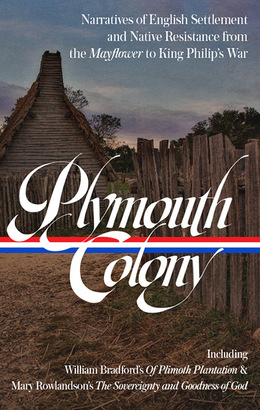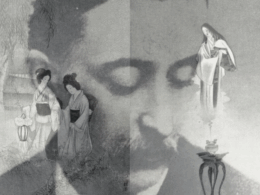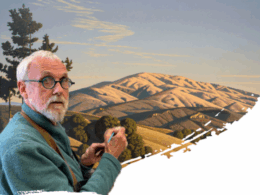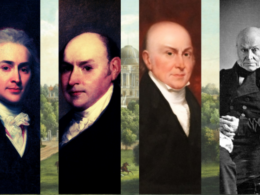This past summer, Library of America published its long-awaited volume, Plymouth Colony: Narratives of English Settlement and Native Resistance from the Mayflower to King Philip’s War, edited by Lisa Brooks and Kelly Wisecup. Brooks is Henry S. Poler ’59 Presidential Teaching Professor of English and American Studies at Amherst College and the author of The Common Pot: The Recovery of Native Space in the Northeast (2008) and Our Beloved Kin: A New History of King Philip’s War (2018), which won the Bancroft Prize. Wisecup is Associate Professor of English at Northwestern University and the author of Assembled for Use: Indigenous Compilation and the Archives of Early Native American Literatures (2021) and editor of “Good News from New England” by Edward Winslow: A Scholarly Edition (2014).
Via email, Brooks and Wisecup answered our questions about Plymouth Colony and the homelands of the Wampanoag people.
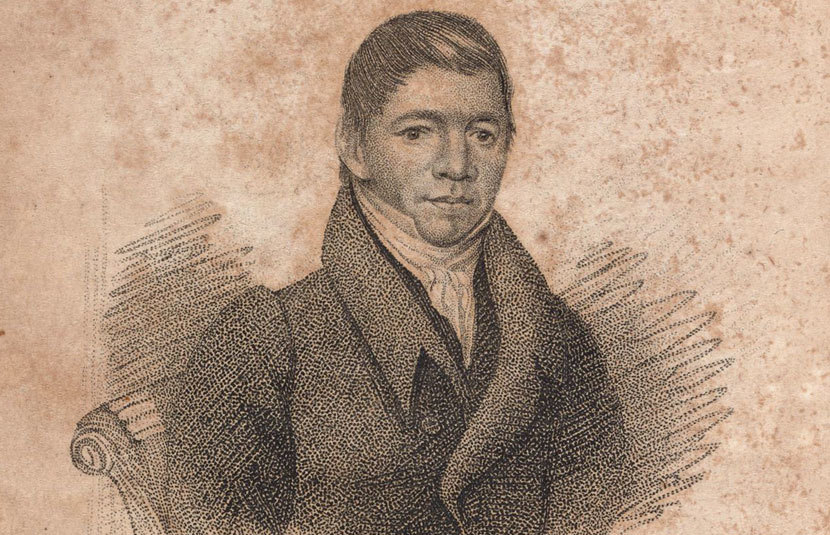
Library of America: In the introduction to Plymouth Colony, you invite readers to “shift orientation” and reconsider transatlantic travel and colonization from the perspective of the Wampanoag homelands. How did this goal affect your selection of texts?
Kelly Wisecup and Lisa Brooks: From the beginning the Library of America editors had expressly invited us to embark on a new path in the series by including Native voices and perspectives as well as writing by English colonists. As the Plymouth 400 commemoration was underway, with Wampanoag people and storytelling being highlighted, a volume that foregrounded Indigenous homelands and perspectives made perfect sense. The public already knows the “Pilgrim” story. But some of the texts we chose help us to tell more than one story.
This meant including many deeds which document Indigenous diplomacy and dispossession as well as some of the rare Native-authored texts from the seventeenth century, such as Wampanoag writing from the Harvard Indian College and petitions by Native scouts and converts. We also sought to include Wampanoag stories of creation, to highlight the thousands of years of Indigenous inhabitation before Plymouth Colony was planted at Patuxet, and Wampanoag writings that came long after Plymouth Colony no longer existed. While Plymouth Colony was relatively short-lived, the Wampanoag nation remained, so we made sure to include several texts from the nineteenth, twentieth, and twenty-first centuries as well those that highlight Wampanoag continuance. Our hope in publishing this volume is that the anthology is not simply about commemoration but also about a different way of engaging with the past and envisioning future paths for Indigenous sovereignty..
A touchstone for our work on the project was “Our” Story: 400 Years of Wampanoag History, a multimedia exhibit produced by the Wampanoag historian Paula Peters and SmokeSygnals that uses video, images, and text to tell stories of colonization and continuance. “Our” Story traveled through New England as an official program of Plymouth 400, and we visited it together while we were gathering the texts and drafting the Introduction for the volume.
LOA: You begin with five European accounts of voyages to the northeast in the early 1600s. What impact did these voyages have on the Indigenous peoples of “the Dawnland,” and how did the observations of these mariners influence the colonists who sailed on the Mayflower?
Wisecup and Brooks: These five accounts depict a series of events in which Indigenous peoples and Europeans added to their knowledge of each other in ways that shaped their engagement with each other in the 1620s. They do not represent the first interactions that Indigenous peoples and European mariners had with each other in the Dawnland; Indigenous peoples had regularly observed men who arrived from the east on ships to fish in the waters off the coast, and Mi’kmaq and Haudenosaunee peoples had interacted with the French navigator Jacques Cartier in the 1530s and 1540s.
James Rosier’s report and Ferdinando Gorges’s account describe how English explorers kidnapped Wabanaki and Wampanoag men and returned with them to England, where their sponsors hoped to teach the Indigenous men English in order to obtain strategic information which would support future settlements. We sought, wherever possible, to include the names of the Indigenous people who were captured and the Indigenous homelands from which they were taken. Several of these captives, including the Wampanoag men Epenow and Tisquantum, returned to their homelands carrying information about English desires for obtaining resources and establishing colonies. This information shaped Wampanoag leaders’ cautious diplomacy with the colonists who later sought to stay permanently on their lands. Some European mariners, including John Smith and Samuel de Champlain, reported seeing extensive cultivated fields and an abundance of fur and fish details that might be of interest to European investors, although they did not always see or understand the extensive agricultural practices and sustainable culture that Indigenous peoples were using to create and maintain that plenty.
These five early European accounts were part of a publication network that circulated accounts of the Americas by English, French, Spanish, and Dutch writers, and shaped English ideas about what colonists might experience in the Americas, including their hopes for cultivating the fertile lands on which Smith and Champlain had reported.
LOA: The volume features writing by Edward Winslow and William Bradford that chronicles the diplomacy with Native peoples that was essential to the survival of the Plymouth colony. What do these accounts tell us about the limits of diplomacy and the problems of cross-cultural understanding between English settlers and Native peoples?
Wisecup and Brooks: A Relation or Journall (also known as Mourt’s Relation, and probably collaboratively authored by Bradford, Winslow, and other Plymouth colonists) and Winslow’s Good News from New England, were written in the early 1620s when everything about Plymouth colony was uncertain, including whether the colonists would survive the first winter of 1620. In addition, because the colonists landed outside the bounds of their original patent from the Virginia Company, their legal status was precarious. It’s important when reading these works to remember this uncertainty and to guard against our knowledge of later events, as if “Plymouth Colony” was already solidified.
Winslow and Bradford were reporting to their investors and addressing potential future settlers. Both A Relation and Good News from New England convey the anxiety that Plymouth colonists felt as they tried to survive a winter for which they were very unprepared and to understand and to meet the expectations of Wampanoag diplomacy. Winslow’s Good News records his travels to Wampanoag villages, where he relied on men like Hobbomock and Tisquantum, who had learned some English, to respond to Ousamequin’s diplomatic overtures. It also describes how the colonists attempted to ease their uncertainty by barricading their settlement and their eventual decision to respond to rumors of a coming attack with the preemptive killing of several Massachusett men. Winslow tailored his account to justify the attack against the Massachusett and to answer criticism from John Robinson, the Plymouth colonists’ minister in Leiden, that such violence against Indigenous peoples was unjust.
Bradford wrote Of Plimoth Plantation over many decades, and it circulated only in manuscript until its first printing in 1856, so it is a history of the colony intended for a very different audience than the quickly published accounts of the 1620s. By the time Bradford was writing Of Plimoth Plantation, between 1630 and 1651, Plymouth colonists were more confident of their ability to trade for or grow their own food. The text’s narrative of a providentially determined destiny for the colony reflects Bradford’s interpretation of the colony’s history. Certainly, such beliefs in a divinely guaranteed right to settlement made colonists approach diplomacy and cross-cultural interaction with a sense of their superiority and a greater willingness to use violence to accomplish their desires.
LOA: How was the section on King Philip’s War influenced by recent scholarship which re-frames the conflict?
Wisecup and Brooks: We assembled this anthology with the help of Lisa’s book Our Beloved Kin: A New History of King Philip’s War (2018), Christine DeLucia’s award-winning Memory Lands: King Philip’s War and the Place of Violence (2018), and the extraordinary Neal Salisbury’s most recent edition of Mary Rowlandson’s The Sovereignty and Goodness of God (2018), which features an outstanding introduction and selection of supplemental texts, including such vitally important documents as the Quaker John Easton’s Relacion of the Indyan Warre and Massachusett scout James Quananopohit’s account of the Nipmuc stronghold of Menimesit. These three books enabled us to center multiple and diverse perspectives on the origins of the war and the conflicts that emerged as the war escalated and spread to multiple Native homelands. We included newly recovered documents, such as John Easton’s account of his meeting with the Wampanoag saunkskwa Weetamoo just before King Philip’s War, as well as the letter Plymouth governor Josiah Winslow wrote to Weetamoo on the eve of war. We include testimony by Native people, as well as the official narratives published by Plymouth Colony. We tried to emphasize primary documents written in the midst of the conflict, rather than the post-war narratives written by Puritan ministers and military leaders, which sought to justify or glorify the war. We also chose to include Mary Rowlandson’s captivity narrative, one of the earliest texts written by an English woman in the colonies. The narrative not only gives the perspective of a Puritan “mistress,” but enables readers to see Native women’s leadership during the war as well as the lives of everyday people who were striving to survive the conflict.
LOA: A section of the book titled “Wampanoag Continuance” brings together writing from the 1830s through 2020. What do these later writings tell us about Plymouth Colony and the Wampanoag homelands?
Wisecup and Brooks: From the beginning of the project, we wanted to include these later writings, which show both Indigenous adaptability and continuing resistance to colonization long after the establishment of the United States. While the “national” story of the founding of the United States long focused on the Plymouth settlers as heroic founders, Native people in New England have repeatedly told a different story. The nineteenth-century Pequot author, activist, and minister William Apess reframed the narrative so that the Native people were the natural heroes who sought to protect their kin and land. He challenged “pretended Christians” to look at their own laws and policies, which continued to oppress their Native neighbors, many of whom were fellow Christians. Apess joined with the Wampanoags of Mashpee to reclaim their land, self-governance, and natural resources during the 1833 Mashpee Woodland Revolt. His narrative of the Revolt records a story of Wampanoag resistance and continuance that many Americans do not know. Similarly, Wamsutta Frank James’s speech at the first National Day of Mourning shows resistance to the celebration of the Pilgrims during the 350th year commemoration in 1970. When his dissenting viewpoint was rejected by the organizers of the commemoration, he proclaimed his speech in protest and initiated a tradition that continues to this day in Plymouth of holding a day of mourning, rather than celebration, on the day that commemorates Plymouth colonists’ arrival. Finally, we invited Wampanoag scholar Linda Coombs to write an essay for the anthology. Linda chaired the Plymouth 400 Wampanoag Advisory Committee and has long played a leadership role in transforming education about Native New England. Her essay, “The Audacity of Assumption,” closes out the section on Wampanoag Continuance, which we think rightly gives Linda the last word.
LOA: Do you have a favorite selection in Plymouth Colony? Are there ones you believe readers will find surprising or unexpected?
Wisecup: I hope that readers spend time with Edward Winslow’s writing, in both A Relation or Journall and Good News from New England. These texts are most interesting for me when Winslow depicts Wampanoag homes and communities. We see them through Winslow’s perspective, of course, but he wrote about moments when he wasn’t quite sure how to act or what the appropriate protocols were, so readers often get more information about Wampanoag peoples and their actions than other colonial reports provided. For instance, in A Relation or Journall, Winslow tells how Wampanoag people welcomed and fed him in their homes, and he gives a detailed description of Ousemequin’s hospitality, writing about the corn and smoked fish served to hungry colonists who arrived in his village on a diplomatic journey. He also writes about his attempts to figure out the geography of Wampanoag homelands, recording his mistaken assumption about distances, and his observations of Wampanoag peoples’ plentiful stores of fish in the summer—a contrast from Plymouth colony’s meager supplies. The period when the Plymouth colonists recognized Wampanoag peoples’ sovereignty over their homelands and understood that they needed to comport themselves accordingly are useful not only for dispelling myths about the colony and its origins, but also as Americans today learn about how Indigenous sovereignty continues.
Brooks: I agree with Kelly. I also hope that readers can delve deeply into these aspects of Winslow’s narrative, especially since William Bradford’s Plimoth Plantation usually gets so much more attention. Both Kelly and I agree that the text we imagine many readers will find most surprising is William Apess’s 1836 Eulogy on King Philip. Apess published this book at a time when many Americans were mourning the “last of the Indians” and even watching portrayals of the Wampanoag leader Philip dying on the stage in theater performances. In New England, the myth of vanishing and disappearance was prevalent. As Apess showed, Native people were not fading away, but rather adapting and surviving. Moreover, it was unjust policies, passed in state houses and Congress, not a naturalized manifest destiny, that was causing great harm to Native communities in New England and far beyond. Apess wrote eloquently and passionately about colonization as a fire that began with Plymouth Colony and spread throughout the land. He warned, with great acuity, that the violence planted by “the Pilgrim fathers” would lead to internal war, predicting the U.S. Civil War, as well as continuing colonial violence against both Native people and people of color. He proclaimed, “We want trumpets that sound like thunder, and men to act as though they were going to war with those corrupt and degrading principles that robs one of all rights, merely because he is ignorant, and of a little different color. Let us have principles that will give every one his due; and then shall wars cease, and the weary find rest.” Although most Americans in the nineteenth and twentieth centuries were more familiar with fictional portraits of Native people, such as James Fenimore Cooper’s novel, The Last of the Mohicans, Apess was remembered by Wampanoag people, and his works are now taught widely in colleges and universities across the country. His writing is an example of what Anishinaabe historian Jean O’Brien calls “Resistance,” a counter to the narratives of “Lasting” and “Replacement.” We hope that his writings will continue to resound.
